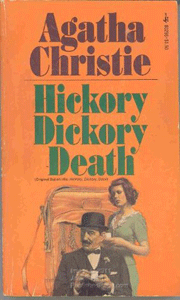Agatha Christie tends to fill her large British houses with lots of characters, the better to supply her story with suspects and victims. “Hickory Dickory Death” (1955, also published as “Hickory Dickory Dock”) is a little different because this isn’t a large family mansion, but rather a boarding house. And the cast is really large.
Sprawling cast
Young men and women – each gender in a separate wing – stay under the eye of matron Mrs. Hubbard, the sister of Hercule Poirot’s efficient secretary Miss Lemon. I should say usually efficient. Here Lemon is flustered by her sister’s problems, and she makes mistakes while typing Poirot’s correspondence!
A reader will have little chance of keeping every boarder straight, even with the helpful dramatis personae at the book’s start. In fact, a late revelation about a link between two characters feels entirely perfunctory to me, but I might have missed the reason why it matters. Still, this is a colorful collection of bantering folks.

“Hickory Dickory Death” (1955)
Also published as: “Hickory Dickory Dock”
Author: Agatha Christie
Genre: Mystery
Series: Hercule Poirot No. 27
Setting: Hickory Road, London, 1955
It’s difficult to keep up with what’s PC nowadays, so it’s possible African student Akibombo is not well-regarded anymore. But for better or worse, he’s memorable. I find his efforts to speak English entertaining. It’s impressive how Christie writes Akibombo’s speech in stunted fashion yet he’s totally understandable.
Mix of personalities
“Hickory” shows the positive and negative ways different personalities rub against each other, from deadly conflicts to sweet romances. Amusingly (and central to the plot), young and dim pharmacist Celia wants to get the attention of young psychologist Colin, so she pretends to be a kleptomaniac.
But — as Poirot, reliable Inspector Sharpe and some of the residents notice – Celia is not clever enough to come up with this scheme on her own. Someone must’ve suggested it to her. But who, and why?
I love the layers in “Hickory.” Characters’ actions sometimes come from multiple people pulling their strings. While Celia stole some of the items on the list Hubbard compiles for Poirot, she didn’t steal all of them. And the order of the thefts matters, as Poirot suspects a chain of cause and effect.
A post-grad Hogwarts
The author plays fast and loose with the setting. I pictured an entire single-story building (the common area) between the two wings, both of which are two stories. But later Christie says the distance between the wings can be covered via a jump. Is there magic involved?
Well, the building, called Hickory Road, reminds me a little of Hogwarts due to the variety of folks, the talky communal meals in a large room, and the fact that the tenants answer to a landlord and a warden. Granted, the boarders are older than Harry Potter and friends by a decade or so.
But these college students and young workers fill Hickory Road with lively noise and action. And it’s just as well that they are adults since Christie is less comfortable writing people in their teens or younger. In “Murder with Mirrors” (1952), for instance, she invents a school for troubled teens but doesn’t introduce many of those teens.

I’m looking forward to watching adaptations of “Hickory Dickory Death” because of the wealth of colorful roles. As for the novel, Christie provides Poirot and the reader with lots of good sleuthing material. It’s of the familiar variety, but with more youthful flair.
Sleuthing Sunday reviews an Agatha Christie book or adaptation. Click here to visit our Agatha Christie Zone.

